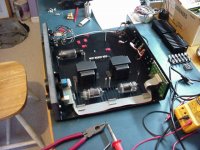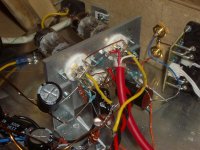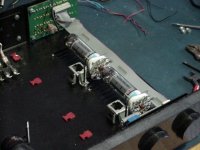Look in your local phone book for Aluminium supplier and then visit their sales office - they often have a bin of off cuts of various angle sections and H sections at very reasonable cost. The angle sections would be ideal for this job.
I visit my local supplier about once every month or so jusy to grab whatever useful off cuts are in the bin.
Cheers,
Ian
I visit my local supplier about once every month or so jusy to grab whatever useful off cuts are in the bin.
Cheers,
Ian
EC8010 said:Please tell me that the heater wiring isn't that red/black twisted pair that goes straight through the audio wiring.
If I count pins correctly, they are going to 4 and 5, so...
Sideways tubes
It is true that some tubes do not like being mounted sideways. The small signal types shown in the picture are fine. In general most indirectly heated tubes can be mounted in any position. Directly heated tubes like the 300B, 2A3, and 45, do not like this. Operating these tubes on their side will cause the filament to sag when it gets hot, shortening its life. In extreme cases it can touch the grid leading to all sorts of unplesant things. Mercury vapor rectifiers don't like being on their side either. The data sheet for each individual tube type (found in a tube manual, or on the net) will usually explain the allowable mounting positions.
I have found that some extruded aluminum scrap from a construction crew that finishes out the interiors of office buildings is quite useful for mounting tube sockets. It punches well with a Greenlee punch. It also makes good heat sinks for power transistors up to about 15 watts dissipation. This stuff is normally used as the top cap for short interior walls.
It is true that some tubes do not like being mounted sideways. The small signal types shown in the picture are fine. In general most indirectly heated tubes can be mounted in any position. Directly heated tubes like the 300B, 2A3, and 45, do not like this. Operating these tubes on their side will cause the filament to sag when it gets hot, shortening its life. In extreme cases it can touch the grid leading to all sorts of unplesant things. Mercury vapor rectifiers don't like being on their side either. The data sheet for each individual tube type (found in a tube manual, or on the net) will usually explain the allowable mounting positions.
I have found that some extruded aluminum scrap from a construction crew that finishes out the interiors of office buildings is quite useful for mounting tube sockets. It punches well with a Greenlee punch. It also makes good heat sinks for power transistors up to about 15 watts dissipation. This stuff is normally used as the top cap for short interior walls.
Please tell me that the heater wiring isn't that red/black twisted pair that goes straight through the audio wiring
eeehh, yes it is. And thats probably why i get a strange high-pitch pulsing sound when i turn it on.
But how the h**l can one keep the wires away when you have to get the tubes heated?
Heater wiring goes in first and is best done with solid core wire (stays in place better). It doesn't need to be very thick for small-signal valves, so it's easy to push it into the corners of the chassis. It should never float in the open air.
However, I doubt that your "strange high-pitch pulsing sound" is due to heater wiring. It's more likely to be due to a wire (or component) from the output going near to an input wire.
However, I doubt that your "strange high-pitch pulsing sound" is due to heater wiring. It's more likely to be due to a wire (or component) from the output going near to an input wire.
well with that out of the way on to the next prob.
my salvaged remote-circuit keeps blowing my fuses.
I have a working +-12VDC supply but when connected to the relays and such at the back the fuses blow. There are five relays (one for each input) and one balanced input. I thought that 125mA fuse should be enough but they keep blowing.
I used it as a passive pre earlier but i managed to use a too bit fuse and the transformer burned.
my salvaged remote-circuit keeps blowing my fuses.
I have a working +-12VDC supply but when connected to the relays and such at the back the fuses blow. There are five relays (one for each input) and one balanced input. I thought that 125mA fuse should be enough but they keep blowing.
I used it as a passive pre earlier but i managed to use a too bit fuse and the transformer burned.
- Status
- This old topic is closed. If you want to reopen this topic, contact a moderator using the "Report Post" button.
- Home
- Amplifiers
- Tubes / Valves
- best material for mounting tubes sideways





